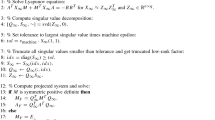Abstract
This article is devoted to the numerical solution of a projected generalized Sylvester equation with relatively small size. Such an equation arises in stability analysis and control problems for descriptor systems including model reduction based on balanced truncation. The algebraic formula of the solution of the projected generalized continuous-time Sylvester equation is presented. A direct method based on the generalized Schur factorization is proposed. Moreover, its low-rank version for problems with low-rank right-hand sides is also proposed. The computational cost of the direct method is estimated. Numerical simulation show that this direct method has high accuracy.
Similar content being viewed by others
References
B. D. O. Anderson, J. B. Moore. Optimal Control-Linear Quadratic Methods. Englewood Cliffs: Prentice-Hall, 1990.
U. Helmke, J. B. Moore. Optimization and Dynamical Systems. London: Springer, 1994.
V. Mehrmann. The autonomous linear quadratic control problem, theory and numerical solution. Lecture Notes in Control and Information Sciences. Heidelberg: Springer, 1991.
P. H. Petkov, N. D. Christov, M. M. Konstantinov. Computational Methods for Linear Control Systems. Hertfordshire: Prentice-Hall, 1991.
T. Stykel. Gramian-based model reduction for descriptor systems. Mathematics of Control, Signals, and Systems, 2004, 16(4): 297–319.
T. Stykel. Low rank iterative methods for projected generalized Lyapunov equations. Electronic Transactions on Numerical Analysis, 2008, 30(1): 187–202.
T. Stykel. Numerical solution and perturbation theory for generalized Lyapunov equations. Linear Algebra and its Applications, 2002, 349(1): 155–185.
T. Stykel. Stability and inertia theorems for generalized Lyapunov equations. Linear Algebra and its Applications, 2002, 355(1): 297–314.
T. Stykel. A modified matrix sign function method for projected Lyapunov equations. System & Control Letters, 2007, 56(11): 695–701.
Y. Lin, L. Bao, Y. Wei. Matrix sign function methods for solving projected generalized continuous-time Sylvester equations. IEEE Transactions on Automatic Control, 2010, 55(11): 2629–2634.
J.W. Demmel, B. Kågström. The generalized Schur decomposition of an arbitrary pencil A — λB: Robust software with error bounds and applicaitons — Part I: Theory and algorithms. ACM Transactions on Mathematical Software, 1993, 19(2): 160–174.
J.W. Demmel, B. Kågström. The generalized Schur decomposition of an arbitrary pencil A — λB: Robust software with error bounds and applications — Part II: Software and applications. ACM Transactions on Mathematical Software, 1993, 19(2): 175–201.
G. H. Golub, C. F. Van Loan. Matrix Computations. Baltimore: Johns Hoplins University Press, 1996.
G. W. Stewart. Error and perturbation bounds for subspaces associated with certain eigenvalue problems. SIAM Review, 1973, 15(4): 727–764.
B. Kågström. A perturbation analysis of the generalized Sylvester equation (AR-LB,DR-LE) = (C, F). SIAM Journal on Matrix Analysis and Applications, 1994, 15(4): 1045–1060.
Y. Lin, Y. Wei. Condition numbers of the generalized Sylvester equation. IEEE Transactions on Automatic Control, 2007, 52(12): 2380–2385.
P. Benner, E. S. Quintana-Ortí, G. Quintana-Ortí. Solving stable Sylvester equations via rational iterative schemes. Journal of Scientific Computing, 2006, 28(1): 51–83.
F. R. Gantmacher. Theory of Matrices. New York: Chelsea, 1959.
P. Benner, V. Mehrmann, V. Sima, et al. SLICOT-a subroutine library in systems and control theory. Applied and Computational Control, Signals and Circuits, 1999, 1(1): 499–539.
I. Jonsson, B. Kågström. Recursive blocked algorithms for solving triangular systems — Part I: one-sided and coupled Sylvester-type matrix equations. ACM Transactions on Mathematical Software, 2002, 28(4): 392–415.
I. Jonsson, B. Kågström. Recursive blocked algorithms for solving triangular systems — Part II: two-sided and generalized Sylvester and Lyapunov matrix equations. ACM Transactions on Mathematical Software, 2002, 28(4): 416–435.
T. Stykel. Balanced truncation model reduction for semidiscretized Stokes equation. Linear Algebra and its Applications, 2006, 415(2): 262–289.
E. Anderson, Z. Bai, C. H. Bischof, et al. LAPACK User’s Guide. Philadelphia: SIAM, 1999.
Author information
Authors and Affiliations
Corresponding author
Additional information
This work was supported by the National Natural Science Foundation of China (Nos. 10801048, 10926150, 11101149), the Natural Science Foundation of Hunan Province (No. 09JJ6014), the Key Program of the Scientific Research Foundation from Education Bureau of Hunan Province (No. 09A033), the Scientific Research Foundation of Education Bureau of Hunan Province for Outstanding Young Scholars in University (No. 10B038), the Science and Technology Planning Project of Hunan Province (No. 2010JT4042), the Young Core Teacher Foundation of Hunan Province in University, and the Fundamental Research Funds for the Central Universities.
Yiqin LIN received his B.S. and Ph.D. degrees in Computational Mathematics from Jilin University in 2000 and from Fudan University in 2005, respectively. He is an associate professor with the Department of Mathematics and Computational Science, Hunan University of Science and Engineering. His research interests focus on numerical linear algebra, computation in control system, saddle point problem and model-order reduction.
Liang BAO received his B.S. and Ph.D. degrees in Computational Mathematics from Fudan University in 2002 and in 2007, respectively. He is an associate professor with the Department of Mathematics, East China University of Science and Technology. His research interests focus on numerical linear algebra and matrix equation.
Yanhua CAO received his B.S. and M.S. degrees in Computational Mathematics from Xiangtan University in 1999 and in 2002, and Ph.D. degree in Computational Mathematics from Fudan University in 2005. He is an associate professor with the Department of Mathematics, North China Electric Power University. His research interests focus on numerical linear algebra.
Liping ZHOU received his B.S. and M.S. degrees in Applied Mathematics from Hunan Normal University in 2000 and from Hunan University in 2003, respectively. He is a lecturer with the Department of Mathematics and Computational Science, Hunan University of Science and Engineering. His research interests focus on numerical linear algebra and matrix equation.
Rights and permissions
About this article
Cite this article
Lin, Y., Bao, L., Cao, Y. et al. A direct method for solving projected generalized continuous-time Sylvester equations. J. Control Theory Appl. 10, 319–324 (2012). https://doi.org/10.1007/s11768-012-0192-x
Received:
Revised:
Published:
Issue Date:
DOI: https://doi.org/10.1007/s11768-012-0192-x




